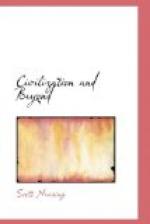In theory the land of Egypt was the property of the Pharoah. Foreign trade was a state monopoly. In practice the ownership and use of land were shared with the temples and with those members of the nobility closest to the ruling monarch. Hence there were state lands and state income and temple lands and temple income. The use of state lands was alloted to favorites. Each temple had land which it used for its own purposes.
Political power in the Old Kingdom was a tight monopoly held by the ruling dynasty of the period. During preceding epochs it seems likely that rival groups or factions had gone through a period of power-survival struggle which eliminated one rival after another until economic ownership and political authority were both vested in the same ruling oligarchs. This struggle for consolidation apparently reached its climax when Menes, a pharoah who began his rule about 3,400 B.C., in the south of Egypt, invaded and conquered the Delta and merged the two kingdoms, South and North, into one nation which preserved its identity and its sovereignty until the Persian Conquest of 525 B.C.
The unification of the northern kingdom with the South seems to have been a slow process, interrupted by insurrections and rebellions in the Delta and in Lybia. Inscriptions report the suppression of these insurrections and give the number of war-captives brought to the south as slaves. In one instance the captives numbered 120,000 in addition to 1,420 small cattle and 400,000 large cattle.
Using these war captives to supplement the home supply of forced and free labor, successive dynasties built temples, palaces and tombs; constructed new cities; drained and irrigated land; sent expeditions to the Sinai peninsula to mine copper. Such enterprises indicate a considerable economic surplus above that required to take care of a growing population: the high degree of organization required to plan and assemble such enterprises, and the considerable engineering and technological capacity necessary for their execution.
Chief among the binding forces holding together the extensive apparatus known as the Old Kingdom was religion, with its gods, its temples and their generous endowments. Each locality consolidated into the Old Kingdom had its gods and their places for worship. In addition to these local religious centers there was an hierarchy of national deities, their temples, temple lands and endowments. The ruling monarch, who was official servitor of the national gods, interpreting their will and adding to the endowments of the temples, was the embodiment of secular and of religious authority.




